Japan
Wood Products Prices
Dollar Exchange Rates of 10th
Sep
2024
Japan Yen 144.37
Reports From Japan
No clear path forward for
Bank of Japan
The Cabinet Office has reported the economy grew at an
annual rate of 2.9%, slower than the earlier report of a
3.1% growth in the April-June quarter. The lower rate
suggests that risks remain, especially because trends in US
economic growth affect export-reliant Japan.
Political uncertainty in Japan is another risk as the ruling
political party picks a new leader. Nine candidates are
seeking to succeed Fumio Kishida as head of the Liberal
Democratic Party and automatically becomes Prime
Minister.
See: https://japantoday.com/category/business/japan's-economy-
is-growing-but-political-uncertainty-is-among-the-risks
Household spending signals cautious consumers
Household spending rose less than expected in July as
consumers remain cautious in the face of rising prices for
every day goods, including food. The sentiment could
complicate any decision by the Bank of Japan on raising
interest rates again.
On a brighter note, Japan's inflation-adjusted take
home
pay rose for the second consecutive month in July. Base
pay increased at the fastest pace in over 30 years in July.
Despite this consumer willingness to purchase durable
goods has remained subdued since the beginning of the
year.
See: https://www.reuters.com/markets/asia/japan-july-household-
spending-edges-up-01-yy-2024-09-05/
Pace of ‘real’ wage growth slows
Real wages rose for a second consecutive month in July
according to the Ministry of Health Labour and Welfare
which is viewed as supporting another interest rate
increase by the Bank of Japan (BoJ). It is reported that
‘real’ earnings for workers climbed 0.4% in July from a
year earlier. While the pace of gains slowed from the
previous month the result beat the consensus projection for
a decline.
The ministry attributed the continued rise in real wages to
more companies paying bonuses compared with a year
earlier.
See:
https://mainichi.jp/english/articles/20240905/p2g/00m/0bu/0170
00c
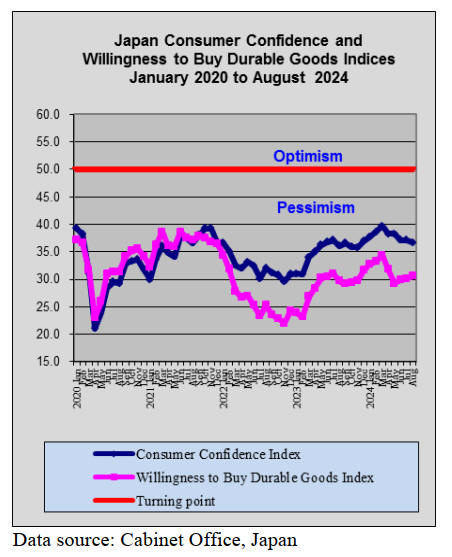
Decision on interest rates hinges on yen movement
The Bank of Japan might find it difficult to raise rates
again this year if the risk of a strengthening yen makes it
imprudent to stick to the plan. An economist at the Dai-
Ichi Life Research Institute has pointed out that the BoJ’s
monetary policy management is increasingly influenced
by foreign-exchange rates.Many anticipate the BoJ aims to
raise rates in December but if the yen retains it stronger
position the need for another rate increase will diminish
which would mean the next rate rise will be in March or
April.
See:
https://www.japantimes.co.jp/business/2024/09/02/economy/boj-
rate-hike-yen-strength/
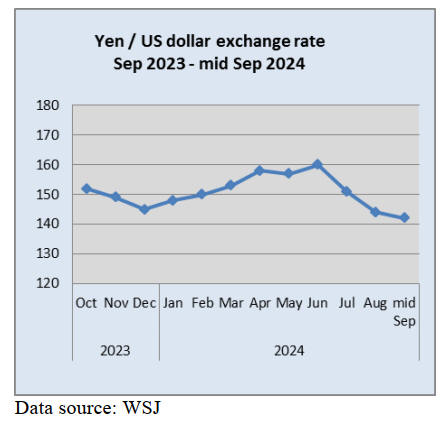
Cashing out real estate holdings
A trend has been observed where Japanese companies
with large real estate asset are cashing out if the land is no
longer central to their business thus freeing up capital to
invest in digital infrastructure and other opportunities.
Some of this momentum stems from investors from
around the world putting pressure on companies to
manage assets more effectively.
See: https://asia.nikkei.com/Spotlight/The-Big-Story/Japan-Inc.-
s-25-trillion-yen-opportunity-cashing-in-on-real-estate
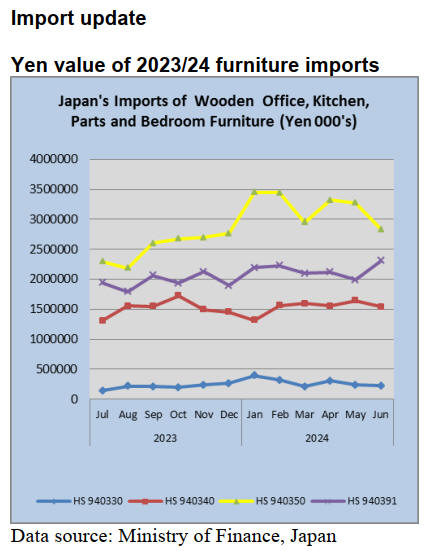
June 2024 wooden office furniture imports (HS
940330)
Year on year, the value of Japan’s imports of wooden
office furniture in June fell 15% and there was a 5%
decline compared to the value of May imports.
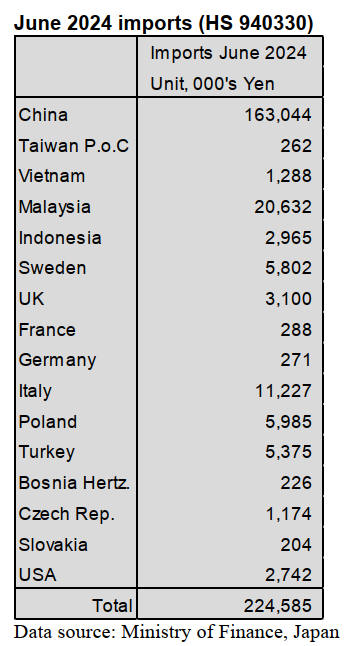
As in previous months, shippers in China accounted
for
the bulk of wooden office furniture imports at just over
70%. The other main shipments in June were from
Malaysia (9% of June imports) down from a month earlier
and Italy (5%) for which there was a rise in the value of
arrivals. In May there were substantial shipments from
Vietnam but this was not the case in June.
June 2024 kitchen furniture imports (HS 940340)
Between February and April this year the value of wooden
kitchen furniture imports were around the same level. In
May, however, there was an uptick in the value of imports
even as the yen strengthened against the US dollar but the
upward movement was not maintained into June as there
was a6% decline in the value of imports compared to a
month earlier.
Year on year, the value of imports of wooden kitchen
furniture items (HS940340) in June little changed,
however, but there were some changes in the shipments
from the main suppliers.
Shippers in the Philippines accounted for around 50% of
June arrivals and did particularly well seeing the value of
shipments to Japan rise. On the other hand, shipments
from the other main shipper, Vietnam, which accounted
for 32% of June arrivals in Japan, saw the value of
shipments drop.
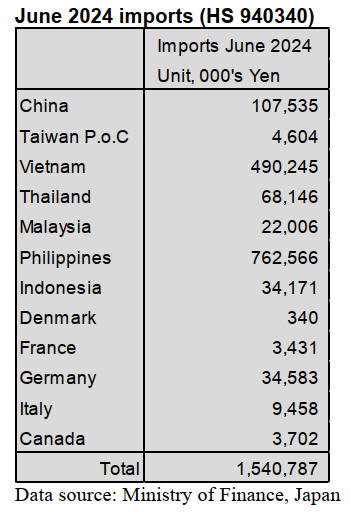
June 2024 wooden bedroom furniture imports (HS
940350)
After the steady increase in the value of imports of
wooden bedroom furniture seen in 2023 things have
hanged.
In the first two months of this year the upward momentum
in the value of imports continued only to stall in March
when there was a sharp downturn followed by an upward
correction which was not sustained into June when there
was a 13% decline in the month on month value of
imports.

Despite the downturn at the end of the second
quarter year
on year, the value of arrivals of wooden bedroom furniture
was up 8%.
Shippers in China and Vietnam accounted for over 90%
of
the value of Japan’s wooden bedroom furniture imports in
June with 58% coming from China and a further 35%
from Vietnam.
Shipments from Malaysia and Thailand combined
accounted for just 6% of the value of June imports.
June 2024 wooden furniture parts imports (HS 940391)
Over the past 12 months there appears to have been a
modest and discernable upward trend in the value of
Japan’s imports of wooden furniture parts. Year on year,
the value of June imports was up 15% and month on
month there was a 16% increase.
Arrivals of wooden furniture parts in June were from a
large number of suppliers particularly those in SE Asia.
However, shippers in Poland and Italy also feature as
significant suppliers. Shippers in China, Indonesia,
Vietnam and Malaysia supplied around 90% of June
arrivals with China topping the list at 46%, Indonesia
20%, Vietnam 12% and Malaysia 10%.
In June the value of shipments of HS940391 to Japan from
China were up sharply as they were also from the other top
shippers with the exception of Vietnam where the June
increase in shipments was more modest.
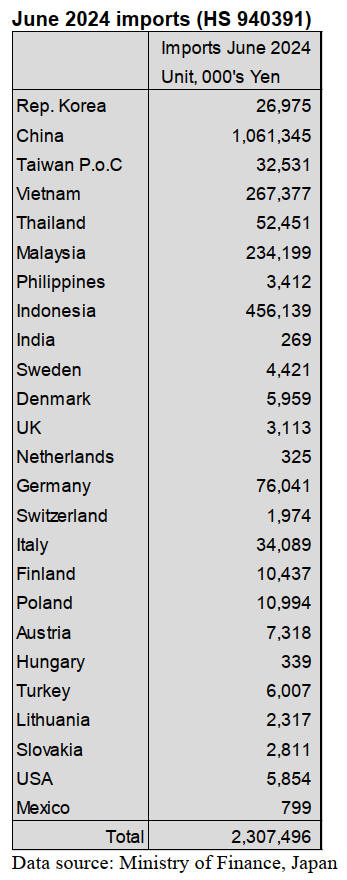
Trade news from the Japan Lumber Reports (JLR)
The Japan Lumber Reports (JLR), a subscription trade
journal published every two weeks in English, is
generously allowing the ITTO Tropical Timber Market
Report to reproduce news on the Japanese market
precisely as it appears in the JLR.
For the JLR report please see:
https://jfpj.jp/japan_lumber_reports/
Housing starts for first half of 2024
Total starts during January to June, 2024 are 391,089
units, 4.5 % less than January to June, 2023. Floor areas of
starts decrease to 300,008,000 square meters, 7.2 % less
than the same period last year as the stats decrease. There
is a possibility that the annual starts would be below
800,000 units this year. The decrease in the starts and the
floor areas influence demand for lumber, building
materials and processing precutting lumber.
Owner’s during January to June, 2024 is 102,066 units, 7.4
% less than the same period last year. Rental during
January to June, 2024 is 167,842 units, 0.6 % down. Unit
built for sale is 60,386 units, 12.4 % down.
Total units of wooden frame construction method for the
first half of 2024 are 162,459 units, 4.7 % less than the
first half of 2023. Prefabricated house is 4,810 units, 4.3 %
less than the same period last year. On the other hand, total
units of 2 4 construction method are 45,874 units, 9.0 %
more than the first half of 2023. Owner’s of 2 x 4
construction method is 13,574 units, 0.8 % up and rental
of 2 x 4 construction method is 28,069 units, 20.6 % up
from the first half of 2023.
Starts of wooden house are 213,143 units, 2.1 % less than
during January to June, 2023. Rental wooden house is
62,568 units, 18.1 % more than the same period last year.
Total floor areas of wooden house are 18,990 square
meters, 6.2 % less than the same period last year. Thus, the
ratio of wooden house during January to June, 2024 is
54.5 %, 1.4 % more than the same period last year.
Total starts in June, 2024 are 66,285 units, 6.7 % less than
June, 2023 and this is straight 2 months for not exceeding
the results of June, 2023. Owner’s is 19,181 units, 5.6 %
less than the same month last year and this is 31 months
decreasing continuously.
Unit built for sale is 10,007 units, 13.8 % less than the
same month last year and this is declining for straight 20
months. Rental is 28,233 units, 6.2 % down and this is
straight 2 months decreasing. SAAR (Seasonally Adjusted
Annual Rate) of unit is 765,000 units, 5.9 % less than
May, 2024.
Orders for house builders
Many housing companies and house builders exceed the
last July’s results. It is hard to say that the demand for
houses had recovered because the orders for houses in
July, 2023 were very low. According to housing
companies, consumers started to purchase houses during
June to July, 2024.
Consumers still take a long time to sign a contract for a
house but a number of contracts is increasing from spring.
There are some consumers, who are in their 40s and
worried about payment period of housing loan, bought
houses. However, it is hard to predict that whether the
housing market would recover fully or not.
There are many orders for apartment buildings and unit
built for sale at the major housing companies. The orders
for apartment buildings are more than unit built for sale.
The price of an apartment building is high due to its high
value-added. The orders for unit built for sale at the major
housing companies are firm and the price of unit built for
sale is still high. The companies have good results in
renovations.
Also, there are many orders from people, who have
already bought houses in the past, and there is a subsidy
for renovations from the government.
Import of North American logs and lumber for 1st half
of 2024
The volume of North American logs at the first half of
2024 was 13.5 % less and North American lumber is 31.7
% more than the first half of 2023. One of reasons for a
decrease in North American logs is the fire occurred at
Chugoku Lumber Co., Ltd.’s plant last August. Then, the
inquiries for imported lumber for wooden framework
construction method rose. Other reasons for the decrease
in Douglas fir logs are low demand, not enough old
Canadian Douglas fir logs and low demand for Canadian
Douglas fir logs for plywood due to a reduction of
producing plywood at Japanese plywood manufacturers.
Some Japanese distributors purchased imported lumber
instead of Chugoku Lumber’s products because the
company had stopped an operation due to the fire. Then,
the volume of Douglas fir lumber was 67.8 % more than
the same period last year. Western hemlock lumber also
increased by 30.1 % from the same period last year.
However, volume of Douglas fir lumber did not decline as
consumers expected due to low demand so small sized
Douglas fir lumber is overstocking.
SPF lumber for wooden framework construction method is
29.8 % more than the same period last year because
demand for rental unit is firm. Also, there had been a
shortage of some kinds of SPF lumber and consumers
purchased a certain number of SPF lumber.
The volume of hardwood logs and lumber decrease around
30% from the first half of 2023. There are enough
inventory of hardwood logs and lumber at manufacturers
and they shy away from high-priced products. As a result,
they started to purchase domestic hardwood lumber.
Domestic lumber and logs
Demand and supply for domestic lumber are different at
the lumber auction market and the precutting market.
Operations at some precutting plants increased in August,
2024.
Therefore, the orders increased for cedar pillar angles at
lumber plants or wholesalers in Kanto region. However, as
the lumber auction market was not lively, many lumber
plants in Tohoku region and Kyushu region control
production.
In the Kanto region, there are not enough cedar pillar
angles due to less supply of logs from Tochigi Prefecture
but the lumber auction market is dull so there is no
problem. The price of KD 105cedar post is around 50,000
– 55,000 yen, delivered per cbm and this is leveled off.
KD 3 m x 105 mm cedar stud is around 58,000 – 60,000
yen, delivered per cbm. The log price fell before the
summer holiday in Easter Japan because there would be
insect damages on logs and consumers reduced purchasing
the logs. The log price in Western Japan is high due to a
lack and a shortage of logs.
The price of cypress log in the northern part of Kanto
region is high. The price of cedar log in Tohoku region
and the northern part of Kanto region kept falling and the
price was under 13,000 yen at the end of August, 2024.
The medium sized larch log for lumber was 18,500 yen,
delivered per cbm.
In Western Japan, a cypress log for a post is around 22,000
yen in Chugoku region and for a sill is around 22,000 yen,
delivered per cbm in Chugoku region, Shikoku region and
Kansai region.
The cypress log for a post and a sill is 20,000 – 20,500
yen, delivered per cbm in Kyushu region. The cedar log
for a post is 14,000 – 15,000 yen, delivered per cbm.
The log price in Eastern Japan did not increase like last
year and the log price in Western Japan is almost flat from
last year. However, the lumber price declined widely from
previous year and there is less profits at the lumber
plants.The log price in Western and Eastern Japan at the
end of this year will become the focus whether up-turn or
not.
Plywood
Sluggish movement of domestic softwood plywood
continues in September, 2024. The price of 12 mm 3 x 6
domestic structural softwood plywood dropped to around
1,180 yen at the end of July, 2024.
As plywood manufacturers or distribution companies
announced to raise the price and the price was about to
reach the bottom. However, low demand for houses,
requests for lowering the price from precutting plants and
the mid-term settlement at the distribution companies have
influenced the price. Consumers do not buy plywood.
Movement of imported plywood is also sluggish in
September. The yen appreciated to 145 yen from 160 yen
at the end of August to September. Malaysian and
Indonesian plywood manufacturers expect to raise the
price and they showed the price by US$20 – 30, C&F per
cbm higher than before.
In South East Asia, 12 mm 3 x 6 painted plywood for
concrete form is US$600, C&F per cbm. Plywood form is
US$510, C&F per cbm and structural plywood is US$520,
C&F per cbm. 2.4 mm 3 x 6 plywood is US$950, C&F per
cbm. 3.7 plywood is US$880, C&F per cbm. 5.2 mm
plywood is US$850, C&F per cbm.
In Japan, 2.5 mm plywood is 780 yen, delivered per
sheet, in Tokyo metropolitan area. 4 mm is 1,000 yen,
delivered per sheet and 5.5 mm is 1,170 – 1,200 yen,
delivered per cbm.
12 mm 3 x 6 painted plywood for concrete form is 1,950
yen, delivered per sheet but some other wholesalers sell it
under 1,900 yen, delivered per sheet.Form plywood is
1,700 – 1,750 yen, delivered per sheet. Structural plywood
is 1,650 yen, delivered per sheet.
|